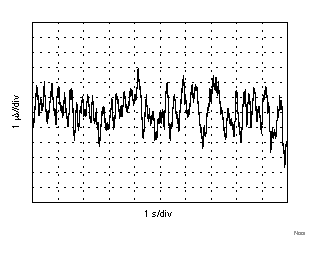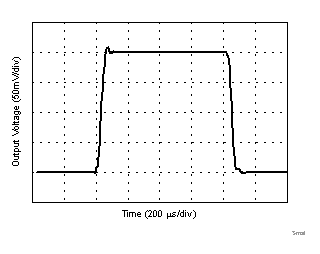SNOSD36A August 2017 – December 2017 LPV821
PRODUCTION DATA.
- 1 Features
- 2 Applications
- 3 Description
- 4 Revision History
- 5 Description (continued)
- 6 Pin Configuration and Functions
- 7 Specifications
- 8 Detailed Description
- 9 Application and Implementation
- 10Power Supply Recommendations
- 11Layout
- 12Device and Documentation Support
- 13Mechanical, Packaging, and Orderable Information
Package Options
Mechanical Data (Package|Pins)
- DBV|5
Thermal pad, mechanical data (Package|Pins)
Orderable Information
7.6 Typical Characteristics
At TA = 25°C, VS = 3.3 V, VCM = VOUT = VS/2, CL = 20 pF, and RL≥ 10 MΩ, unless otherwise noted.
| VS = 1.8 V | N = 98 units | TA = -40°C |

| VS = 1.8 V | N = 98 units | TA = 125°C |

| VS = 3.3 V | N = 98 units | TA = 25°C |

| VS = 1.8 V | N = 98 units |

| VS = 3.3 V | N = 98 units |

| VS = 1.8 V | CL = 20 pF | TA = –40, 25, 125°C |

| VS = 1.8 V |

| VS = 1.8 V |

| VS = 1.8 V |

| VS = 3.3 V and 1.8 V |

| VS = 3.3 V and 1.8 V |

Figure 23. EMIRR Performance

| VS = 3.3 V and 1.8 V |

| VS = 3.3 V |

| VS = 1.8 V | TA = –40, 25, 125°C |

| VS = 1.8 V | TA = –40, 25, 125°C |

| VIN = 2.64 VPP | G = 1 | RL = 1 MΩ |

| VIN = 0.2 VPP | G = 1 | RL = 1 MΩ |

| VS = 1.8 V | N = 98 units | TA = 25°C |

| VS = 3.3 V | N = 98 units | TA = -40°C |

| VS = 3.3 V | N = 98 units | TA = 125°C |

| VS = 3.3 V | N = 98 units |

| TA = –40, 25, 125°C |

| VS = 3.3 V | CL = 20 pF | TA = –40, 25, 125°C |

| VS = 3.3 V |

| VS = 3.3 V |

| VS = 3.3 V |

1.
Figure 20. Input Bias Current on –IN Input Pin vs Temperature| VS = 3.3 V and 1.8 V |

| VS = 3.3 V and 1.8 V |

| TA = –40, 25, 125°C |

Figure 26. Voltage Noise Spectral Density vs Frequency

| VS = 1.8 V |

| VS = 3.3 V | TA = –40, 25, 125°C |

| VS = 3.3 V | TA = –40, 25, 125°C |

| VIN = 1.44 VPP | G = 1 | RL = 1 MΩ |

| VIN = 0.2 VPP | G = 1 | RL = 1 MΩ |